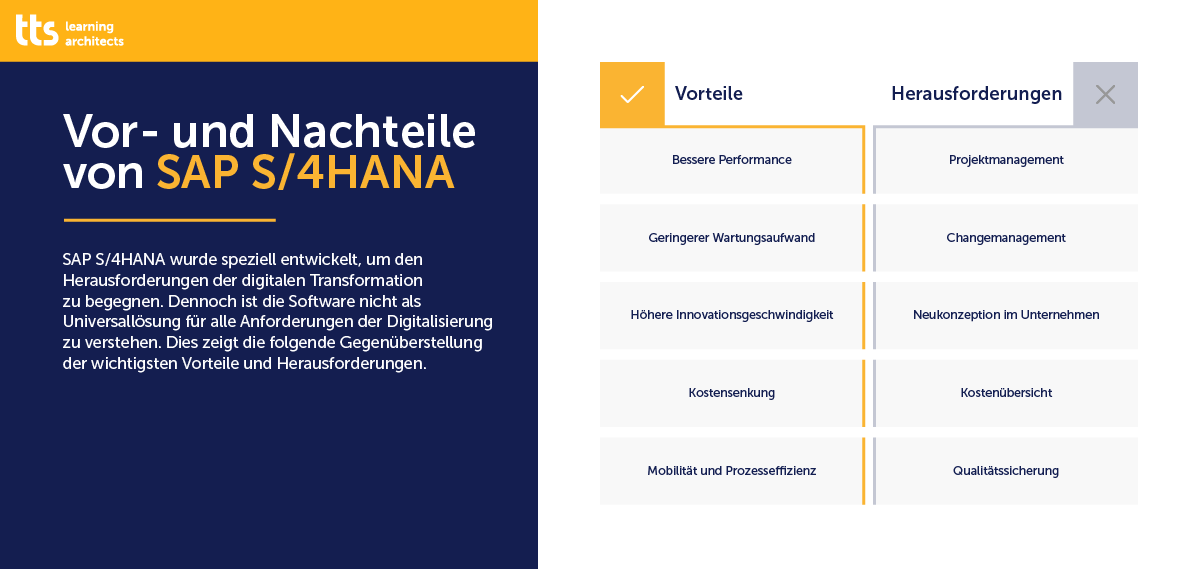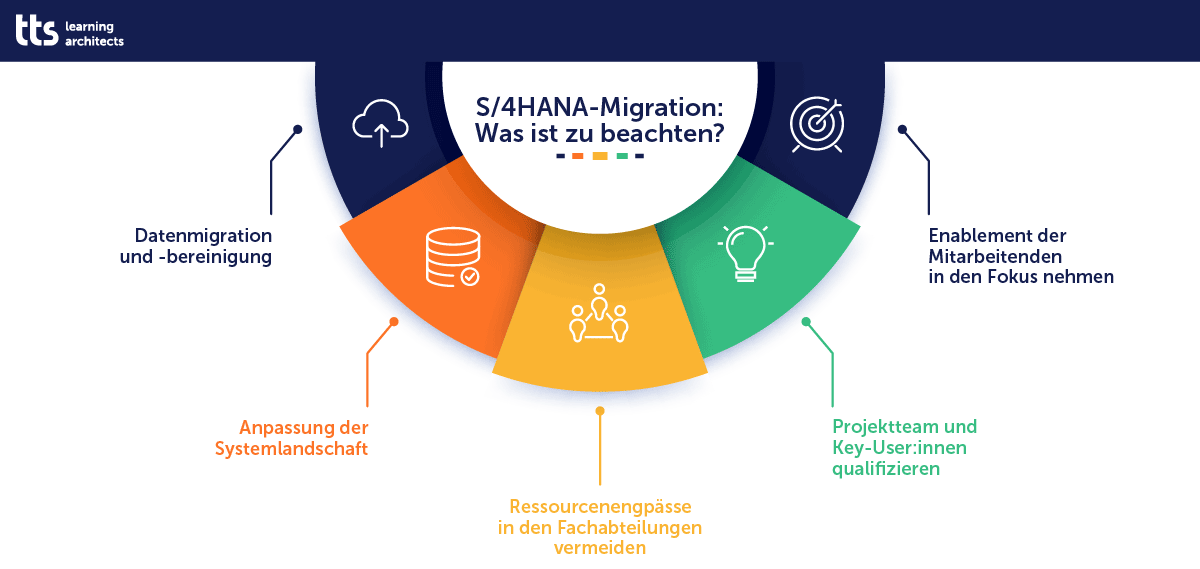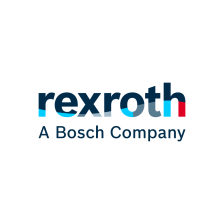
SAP S/4HANA - everything you need to know now
Cost efficiency and the ability to react quickly and based on data to new requirements are now more crucial than ever for the success of a company, regardless of the industry. SAP S/4HANA is designed to provide the right foundation for precisely this. Indeed, the latest ERP business suite has a lot to offer, above all significantly better performance, new AI-supported functions and numerous simplifications that help companies shed ballast and become more agile. However, it is also a fact that the changeover and the introduction of SAP S/4HANA represent an enormous challenge for the entire organization.
This makes it all the more important to carefully plan the journey towards SAP S/4HANA and set all the necessary course in advance. This article will help you do this. You will learn more about the most important functions, editions and their possible applications and receive a comprehensive overview of SAP S/4HANA. The article highlights the benefits and challenges, introduces the various elements and explains what is important for a successful migration. You will be well equipped to make the most of the new features and benefits of the cloud ERP software to achieve your business goals and avoid any pitfalls.

SAP S/4HANA: SAP's most powerful ERP solution to date for optimizing business processes - in the cloud
SAP S/4HANA is a fourth-generation business suite from SAP. The software can be integrated into various modules: on-premises, as a cloud solution or as a hybrid variant. The successor to the SAP R/3 and SAP ERP Central Component (SAP ECC) software offerings was developed to enable companies to meet the requirements of the digital economy at all times and adapt to market changes quickly and efficiently. Various packages - RISE with SAP (SAP S/4HANA Cloud Private Edition) and GROW with SAP (SAP S/4HANA Cloud Public Edition) - are designed to facilitate implementation. The new release therefore offers more than just a new enterprise resource planning system: all business areas can be seamlessly covered.
The differences between SAP S/4HANA and previous SAP ERP products lie primarily in the technological basis, the in-memory technology SAP HANA (= High Performance Analytic Appliance) and the radically simplified data model, which largely eliminates redundant data storage and reduces storage requirements by up to 50 percent. As a result, all important business data can be stored completely in the working memory, where it can be processed much faster. In practice, this means that all employees can access live data and are always up to date. At the same time, the technology makes it possible to find solutions to problems based on business scenario simulations or checks in real time and to make data-based decisions.
As part of the "Cloud First" strategy, the ERP also offers comprehensive options and support for cloud operation of SAP S/4HANA and migration to the cloud. This gives customers the opportunity to use additional decision support tools and AI to adapt their workflows, which has a positive effect when integrating a cloud ERP. The new version also offers a personalized, role-based user interface with SAP Fiori, which is based on apps from the consumer sector and can be used not only on the computer in the office, but also on the go via smartphone or tablet. RISE with SAP makes it possible to move to the cloud without having to re-implement SAP.
What are the advantages and disadvantages of SAP S/4HANA?
The switch to SAP S/4HANA promises considerable added value, as the current ERP generation was developed by SAP as a direct response to the many challenges of digital transformation. Nevertheless, the software should by no means be seen as a panacea for mastering all the requirements of digitalization, as the following comparison of the most important benefits and challenges shows:

Advantages of SAP S/4HANA
Better performance
SAP S/4HANA has only half as many lines of code, data elements and tables as SAP ERP Central Component (SAP ECC). In combination with the SAP HANA in-memory database, this results in significantly faster response times, enabling real-time decisions based on simulations, forecasts or data visualizations.
Less maintenance required
By using a central database, the system architecture of SAP S/4HANA is less complex than that of its predecessors SAP R/3 and SAP ECC. This reduces maintenance costs and simplifies system administration.
Higher speed of innovation
SAP S/4HANA brings with it numerous new functions, including advanced analysis options, AI tools, machine learning and the integration of IoT applications. This gives customers extensive opportunities to develop innovative business models, standardize processes and take advantage of the opportunities offered by digitalization.
Cost reduction
The simplified automation and customization of workflows with SAP S/4HANA enable extensive cost savings. Additional savings can also be realized thanks to the leaner system architecture and the option to use the cloud or take advantage of software-as-a-service offerings.
Mobility and process efficiency
SAP Fiori significantly improves the usability of the applications. At the same time, it ensures that users can quickly find their way around and that processes can be initiated from any location and run efficiently on any device.
Challenges of an SAP S/4HANA project
However, the migration to SAP S/4HANA is also associated with considerable challenges. The most important ones are briefly discussed here:
Project management
The implementation of SAP S/4HANA cannot be regarded as a pure IT project, as technical topics dominate much more than is usual for other SAP projects. This makes the planning and execution of the implementation unusually complex and requires the coordination of all relevant stakeholders.
Change management
The changeover to SAP S/4HANA leads to significant changes that affect the entire organization. Effective change management is crucial to ensure the acceptance and commitment of employees. To achieve this, everyone involved must be informed, convinced and trained in good time.
New conception in the company
Depending on the level of integration, all processes have to be checked, reverted to the standard or set up from scratch. In addition, the data must be prepared for the simplified data model.
Cost overview
The project managers must carefully calculate and monitor the total costs of the project, including integration, license fees, operating costs, training and external support. To avoid a resource bottleneck for key users later on in the project, the costs for user qualification must not be underestimated under any circumstances. The aim is to set a realistic budget that takes all cost factors into account.
Quality assurance
For the introduction of SAP S/4HANA to be successful, comprehensive quality assurance is required. This includes testing and validating the new systems and processes to ensure that they meet the requirements and function smoothly.

Which SAP S/4HANA modules are available with the new ERP from SAP?
With SAP S/4HANA, SAP is attempting to bundle workflows into end-to-end processes rather than modules. Nevertheless, most people still talk about "modules". SAP S/4HANA offers modules for different business areas, so-called Lines of Business (LoB), which support companies in optimizing the following processes:
- Finance includes financial accounting, controlling, treasury and risk management as well as reporting and enables better decisions in financial management.
- Asset management supports the efficient management and optimization of assets over their entire life cycle.
- Human Resources covers all HR-related processes, including talent management, in real time and strengthens employee loyalty.
- Manufacturing offers functions for production planning and control, including scheduling and delivery planning, as well as for quality management.
- Marketing and Commerce enables the implementation of targeted marketing and sales campaigns.
- Research and Development increases the pace of innovation and boosts processes in research, development and the market launch of new products and services.
- Sales covers the sales processes from customer management to order processing.
- Customer Service supports the development, optimization and automation of customer-centric solutions.
- Sourcing and Procurement optimizes procurement processes and cooperation with suppliers, while at the same time reducing procurement costs.
- Supply Chain enables precise and transparent control of the supply chain, including production planning, batch tracing, warehousing, inventory and transportation management.
What should be considered when planning an SAP S/4HANA roadmap?
Planning an SAP S/4HANA roadmap requires careful consideration and preparation to ensure the upgrade runs smoothly and to kick-start the transformation:
1. do not underestimate the duration of the project
According to SAP, the changeover to SAP S/4HANA should be completed in 12 to 18 months. However, surveys show that a project duration of two to four years - depending on the depth and scope of integration - should be expected.
2. forward or backward planning?
Companies can consider either backward or forward planning. Backward planning is useful when a fixed go-live date is specified and works backwards through the required steps. Forward planning starts with the current status and organizes all milestones along the timeline based on available resources.
3. check availability of the IT department
The availability of the IT department is crucial to the success of the project. If necessary, external expertise should be booked at an early stage, as available capacity could quickly become scarce the closer the end of the support phase approaches.
4. integrate specialist departments
The changeover to SAP S/4HANA requires close cooperation between IT and the specialist departments. Above all, the availability of key users is crucial in order to correctly understand and implement the requirements and processes.
5. the project team needs process know-how
A deep understanding of the workflows is the key prerequisite for a successful changeover. In order for the project team to be able to check and optimize the workflow, it must have detailed know-how.
6. assess the extent of contaminated sites
The amount and complexity of existing data, instances and systems have a significant impact on the planning and migration process. For this reason, the scope of the legacy data should be carefully analyzed and evaluated. In this way, delays can be avoided and escalating costs prevented.
7. set up comprehensive change management
To ensure that the new systems and processes are accepted and used, the switch to SAP S/4HANA requires effective change management. This includes communicating the project goals and progress, including suitable feedback mechanisms, training employees and supporting them in learning the new processes in the workplace. Caution: SAP S/4HANA projects often focus exclusively on the technical connection, but inadequate change management and a lack of training pose a major threat to the success of the project.
8. use project experience
Experience from previous projects provides valuable insights for the planning and execution of the SAP S/4HANA implementation. Reviewing and evaluating previous errors and successes helps to predict and avoid problems. It can make sense to seek external support here. Companies that specialize in the implementation of SAP S/4HANA usually have valuable experience with such projects.
9. minimize risks through preliminary projects
Pre-projects offer an ideal opportunity to test and optimize certain aspects of the changeover, such as the analysis and cleansing of data or the testing of newly standardized processes, on a smaller scale in advance. This allows risks to be minimized and SAP best practices to be developed for the final changeover.
Bosch, RWE und viele weitere Unternehmen arbeiten bereits erfolgreich mit tts zusammen. Vereinbaren Sie jetzt einen Termin und erfahren Sie, wie mit effektivem Changemanagement und passenden Lernangeboten Ihr SAP-Projekt ein Erfolg wird!

What is the SAP HANA database?
The basis for SAP S/4HANA is SAP HANA, a database with in-memory technology. In-memory means that the CPUs do not need to access hard disks or SSDs for their calculations because all the required data is stored in the main memory (RAM). This streamlining of the architecture saves enormous amounts of storage space: around 50 percent of the tables, lines of code and data elements previously required are no longer needed.
In addition, the data is organized in columns instead of rows. In this way, transactional and analytical functions can be processed in parallel in one system. This enables extremely fast response times, which were not possible with the previous versions, and allows forecasts or analyses to be carried out in real time. The switch to SAP S/4HANA offers competitive advantages through knowledge in the truest sense of the word.
Another advantage of the SAP HANA database is its compatibility with older SAP ERP systems. Customers can therefore benefit from the program's improved performance and enhanced functions without having to rebuild their entire IT infrastructure. By offering companies the opportunity to gradually migrate their data and systems, SAP is making it easier for them to switch to SAP S/4HANA.
What is SAP Fiori?
SAP Fiori is a collection of applications (apps) and user interfaces (UI) that have been specially developed to improve the use of SAP S/4HANA and other SAP solutions. Compared to the outdated UI of the previous version, SAP Fiori apps are easy to use and offer users optimal support in completing their tasks. The SAP Fiori user interface is comparable to mobile applications and can be used flexibly just like them.
The following features in particular ensure greater acceptance and productivity: SAP Fiori is
- Customizable: Users can customize their home screens and dashboards by adding the apps and information that are relevant to them.
- role-based: The apps are tailored to the needs and working methods of the various roles in the company. This means that users only see and use the functions that are relevant to their tasks. This simplifies navigation and operation of the software.
- team-oriented: The element is seamlessly integrated into other SAP solutions and modules. This means that employees can easily switch between different applications, exchange information or collaborate without leaving the user interface.
- responsive and mobile: the apps automatically adapt to different screen sizes and resolutions. This allows access to all functions with any standard end device, whether desktop PC, tablet or smartphone.

How do you migrate to SAP S/4HANA?
There are two main approaches to SAP S/4HANA implementation, the brownfield approach and the greenfield approach; both can be combined to form the so-called colorfield or bluefield approach. Each of these approaches has advantages and disadvantages. The choice of the appropriate approach therefore depends on the specific requirements, objectives and also the resources of the company and requires a careful evaluation of the current system, workflows and future requirements.
Brownfield implementation
With the brownfield approach, the existing SAP landscape is transferred to SAP S/4HANA. The processes and data structures are largely retained. This approach is particularly suitable for companies that do not want to change their processes but want to benefit from the future viability and technical advantages of the new ERP software.
Advantages of a brownfield implementation:
- The cost of converting existing systems is lower and is generally more cost-effective than a new implementation.
- Linking takes less time because the existing processes and data are adopted.
- As the existing processes are retained, the training effort for users is also lower.
Disadvantages of a brownfield implementation:
- Legacy issues such as inefficient processes and data structures are transferred to the new software.
- The options for optimizing workflows are limited.
- The transformation and innovation potential of the software is hardly used.
Greenfield implementation
In a greenfield implementation, SAP S/4HANA is set up and configured from scratch, so to speak. This approach therefore offers the possibility of optimally adapting the system to the company's current and future needs.
Advantages of a greenfield implementation:
- The potential of SAP S/4HANA can be fully utilized and exploited regardless of legacy issues.
- The structure of the new system and the business processes can be fully adapted to current requirements.
Disadvantages of a greenfield implementation:
- The changeover is generally more costly and time-consuming than a brownfield implementation.
- The change impact is significantly greater because previous workflows and data practices change from the ground up.
What needs to be considered when migrating to SAP S/4HANA?
According to a recent survey, the three biggest challenges when introducing SAP S/4HANA are data migration (39%), adapting the IT landscape (37%) and a lack of personnel in the specialist departments (36%). However, the list of challenges is actually much longer because ERP migration is a transformation project in which all parts of the company are in motion at the same time and are often out of balance.

Migration and cleansing of data
If the data model changes when switching to SAP S/4HANA, a company-wide migration of the data is absolutely essential. This is one of the most critical steps in the changeover. The crux of the matter is to radically simplify the data structure, for example by creating just one uniform business partner master with all characteristics instead of distributing these characteristics across "customer, "vendor" and "business partner" as was previously the case.
This avoids workflows that are laborious and error-prone. However, this requires that all relevant data is thoroughly analysed, cleansed, transformed and optimized before it is adapted to the new structures. With SAP Solutions for Enterprise Information Management, SAP provides a range of different solutions with which many of these work steps can be carried out efficiently.
Adaptation of the system landscape
Switching from an existing SAP ERP solution to SAP S/4HANA requires various adjustments to the system landscape so that the new functions and technologies can be used optimally.
For example, the SAP HANA in-memory database runs exclusively on Linux. It also requires significantly more RAM than conventional databases, and users can only benefit from the fast response times of SAP S/4HANA if the network infrastructure is set up with the appropriate performance.
Existing applications and customer-specific solutions may need to be revised, updated or even redeveloped so that they are compatible with SAP S/4HANA and function smoothly. The SAP Readiness Check can be used to check the status of the existing IT architecture in this regard in advance.
Avoid resource bottlenecks in the specialist departments
Furthermore, the switch to SAP S/4HANA requires the intensive involvement of the specialist departments. To avoid bottlenecks, detailed resource planning should therefore be carried out at an early stage to determine the availability of all relevant key users. Time buffers in project planning help to cushion delays or staff absences. To avoid overloading, resources should be focused on the most important project phases and tasks. Gradual integration of individual modules or business areas also reduces the workload on specialist departments, while resource management tools help to efficiently control the planning and distribution of tasks.
Additional relief is provided by the use of automation solutions, but also by bringing in external experts to support the key users, for example with documentation and user training.
Qualify the project team and key users before the migration
In order for the project team and key users to be able to contribute to the redesign of the processes efficiently and with commitment, they must first develop a comprehensive understanding of the program and acquire specific detailed knowledge. This can be done by implementing a comprehensive training program that imparts both theoretical knowledge and practical know-how.
In addition, the key users should be given the opportunity to familiarize themselves with the new SAP S/4HANA functions as part of a trial installation during their daily work. The key users in particular should receive especially intensive training and work closely with the project team to ensure a smooth adaptation and introduction of the new processes. In addition, regular feedback loops should be set up to enable the rapid optimization of processes and help to eliminate acceptance problems.
Focus on the enablement of employees
Ultimately, however, the success or failure of a migration depends on the end users, i.e. the employees in the specialist departments, and on how well they have been prepared for the change through training and other qualification measures. These training courses should be offered in various formats such as face-to-face seminars, webinars and e-learning in order to accommodate the different learning styles and schedules of employees.
It is also important to promote a culture of learning and innovation with the help of platforms and forums, for example, where employees can share experiences, discuss best practices and jointly develop solutions to problems that arise.
The use of a Digital Adoption Platform (DAP) has proven to be particularly efficient here. It provides assistance with applications and processes directly at the workplace and enables the continuous analysis and optimization of the learning process by identifying individual learning progress and difficulties. This not only has a positive effect on the application and process knowledge of individual employees, but also on their motivation to actively participate in the successful data migration to SAP S/4HANA.
Mehr als 6.000.000 User:innen nutzen bereits die Digital Adoption Platform tts performance suite. Worauf warten Sie? Vereinbaren Sie jetzt Ihre persönliche Demo – kostenlos und unverbindlich!
SAP S/4HANA: Five tips for successful implementation
- Check your data and business processes in terms of frequency of use, quality and optimization options with the SAP Readiness Check in the SAP Support Portal. This will not only provide you with information on possible system conflicts and ballast, but also recommendations for action for your migration path.
- Develop a detailed migration plan with defined milestones and select a worthwhile preliminary project that will allow you to achieve rapid success with manageable effort and risk.
- Data migration to SAP S/4HANA is not an IT project, but a change project. Therefore, give high priority to qualifying your specialist departments and employees so that your company can efficiently utilize the potential of SAP S/4HANA without acceptance problems and unnecessary detours.
- Use the new technology not only for data transfer, but also as an opportunity to question and optimize existing processes. You can automate the selected processes with the help of Robotic Process Automation (RPA).
- Involve the affected departments and employees in the transformation as early as possible. Turn those affected into participants - through intensive, transparent communication and appropriate feedback mechanisms. And don't forget to celebrate every transformation success!
Conclusion
In just a few years, SAP R/3 and SAP ECC will be history. The future belongs to the SAP S/4HANA suite, a modern ERP software that enables real-time data processing, a wide range of options for process digitization and better decision-making.
To ensure a smooth transition, it is all the more important to carefully plan the data migration today and identify challenges that are critical to success.
Take the opportunity to take your company to a new level of transformation and contact us if you have any questions about SAP, the relevant edition and its successes. As an experienced SAP partner, we will be happy to support you in converting your company to SAP S/4HANA.
Bosch, RWE and many other companies already work successfully with tts. Arrange an appointment now and find out how you can avoid resource bottlenecks and make your SAP project a success!








